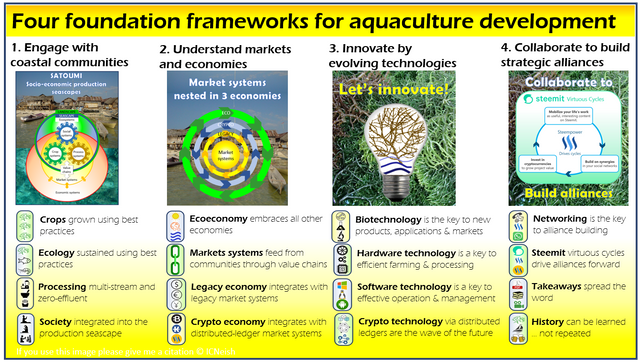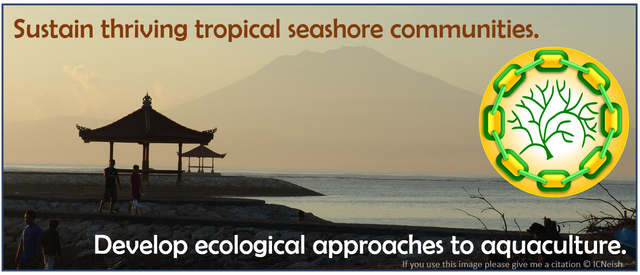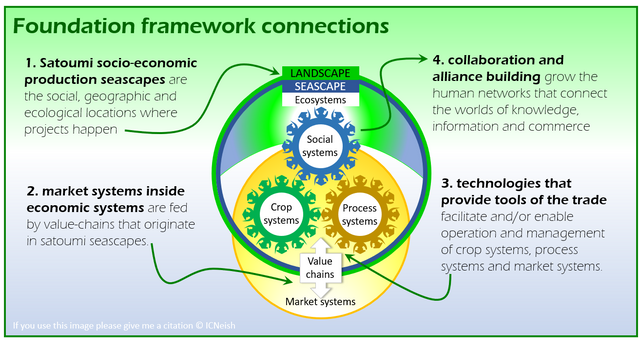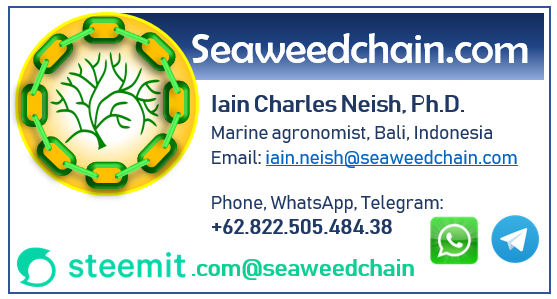Tropical aquaculture can grow sustainably only if it is integrated into the socio-economic and ecological environments of coastal communities.
The concepts of satoumi and satoyama are at the core of the SeaweedChain approach to aquaculture value chain development.
For more than 40 years, I have had the good fortune to work with brilliant colleagues in hundreds of seashore communities in the tropics. We were building conceptual frameworks for executing projects but had no overarching philosophy and had no term that embraced our guiding concept. An epiphany came when I stumbled across the Japanese concept of ‘satoumi’ about ten years ago. This was not only a ‘term’ … it was also a grounded philosophical framework!
The word ‘satoumi’ was created by Professor Tetsuo Yanagi of Kyushu University about 1998. In Japanese “sato” means village and “umi” means the sea so Yanagi defined ‘satoumi’ as “High productivity and biodiversity in the coastal sea area with human interaction” (Yanagi, 2008). The term “satoumi” was derived from ‘satoyama’ which is a Japanese concept for long-standing traditions associated with land management practices in mountainous regions. In Japan such traditions have fostered sustainable use of resources through symbiotic human interaction with ecosystems. They provide a model for environmental stewardship and resource management that contributes to human well-being.
SeaweedChain on Steemit is complementary to Seaweedchain.com

The image above reflects the homepage and sitemap of Seaweedchain.com. The Seaweedchain.com website and the Steemit.com@seaweedchain feed are complementary endeavors toward contributing useful content to growing agri-aquaculture communities around the world. The conceptual framework of our approach is defined by four connected foundation frameworks, each of which embraces four spheres of activity. The frameworks are connected as shown below.
The first framework is satoumi seascapes
Development of tropical aquaculture projects begins with satoumi seascapes for legal, moral, ethical and practical reasons. One compelling factor is that in many major jurisdictions (including Indonesia) coastal villages have the legal right to own and manage the foreshores adjacent to their villages. These villages are also where many of our workers and value-chain connections can be found. Connecting into coastal communities is a very complex endeavor so aquaculture project developers and operators can benefit from sharing their experiences and building a comprehensive set of best practices. The SeaweedChain project is striving to contribute to that effort.
The second framework is market systems inside economic systems
I suggest that many aquaculture industry woes (certainly in the case of seaweed farming) are caused by sloppy value chain management. In general value chains are opaque so the connections between ‘supply’ and ‘demand’ are poorly understood at all levels of the value chain. I postulate that this situation is a major cause of industry disfunctions described in my recent Steemit post entitled “Innovation can invigorate bogged-down tropical seaweed value chains”.
I have sat through numerous presentations where planning authorities, industry groups and aid agencies have painted scenarios of seaweed farm development that are seriously disconnected from value chain facts and economic realities. I have made this case several times in presentations and books (e.g. Neish et al 2018 and Neish and Suryanarayan 2018) but communications by such means has not been effective. I hope that SeaweedChain on Steemit and my website can be a move toward getting points across more effectively.
The third framework is a suite of technologies that provides the tools of the trade
Innovations in newly developing technologies are enabling step changes that can drive tropical seaweed farming growth again after the decade of stagnation and supply / demand disruption described in my recent “bogged-down value chains” post.
Advances in biotechnology have enabled development of seaweed-derived agricultural biostimulants products with standardized potency and known efficacy. Advances in hardware technology are enabling simple mechanization, effective crop logging and more efficient processing. Advances in software have transformed management practices and the advent of distributed ledger technologies promises to bring about step changes in value-chain management. The SeaweedChain project is striving to contribute to those advances.
The fourth framework is collaboration and alliance building
Aquaculture value chains in general (and seaweed value chains in particular) are dependent on trust-based strategic business alliances. Unfortunately, ‘trust’ can be expensive and time consuming to develop, and trust relationships are easily shattered by death, alienation, corporate restructuring, neglect and other events. This is where distributed-ledger technologies such as blockchains can have a profound impact.
While interpersonal relationships will always be the central core of business collaboration and alliances, value chain transaction paths can be hugely facilitated by the efficiencies of distributed ledgers and by minimization of dependence on trust through use of consensus algorithms.
So full Steem ahead! Cheers, Iain
References:
Neish IC, Sepulveda M, Hurtado AQ & Critchley AT. 2018. Reflections on the commercial development of eucheumatoid seaweed farming, Chapter 1 in Tropical Seaweed Farming Trends, Problems and Opportunities: Focus on Kappaphycus and Eucheuma of Commerce, Hurtado AQ, Critchley AT & Neish IC [Eds], ISBN 978-3-319-63498-2, Springer.
Neish IC & Suryanarayan S. 2018. Development of eucheumatoid seaweed value-chains through carrageenan and beyond. Chapter 12 in Tropical Seaweed Farming Trends, Problems and Opportunities: Focus on Kappaphycus and Eucheuma of Commerce, Hurtado AQ, Critchley AT & Neish IC [Eds], ISBN 978-3-319-63498-2, Springer.
Yanagi, Tetsuo (2008). “Sato-Umi”—A New Concept for Sustainable Fisheries. In K. Tsukamoto, T. Kawamura, T. Takeuchi, T. D. Beard, Jr. and M. J. Kaiser, eds. Fisheries for Global Welfare and Environment, 5th World Fisheries Congress 2008, pp. 351–358. © by TERRAPUB 2008. [wfcbk_351.pdf]



Good information specially for Indonesian people
Downvoting a post can decrease pending rewards and make it less visible. Common reasons:
Submit
Thanks sanjum. Indonesia is where I live and work with my Indonesian family in Bali ... Iain
Downvoting a post can decrease pending rewards and make it less visible. Common reasons:
Submit